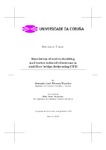Simulation of vortex shedding and vortex induced vibrations in multibox bridge decks using CFD

Use este enlace para citar
http://hdl.handle.net/2183/23579
A non ser que se indique outra cousa, a licenza do ítem descríbese como Atribución-NoComercial-SinDerivadas 4.0
Coleccións
- Teses de doutoramento [2232]
Metadatos
Mostrar o rexistro completo do ítemTítulo
Simulation of vortex shedding and vortex induced vibrations in multibox bridge decks using CFDAutor(es)
Director(es)
Nieto Mouronte, FélixData
2019Resumo
[Abstract] In long-span bridge engineering the designer must consider a wide range of economical,
environmental and structural aspects in order to obtain a safe, and
economical prototype that fulfils the design constraints and satisfies the needs of
the potential users. These give rise to the refurbishing of existing ageing bridges
and the proposal of new bridges, which thanks to the advances in design tools,
methods, physical theories and models, allow to design long-span bridges in sites
where a feasible solution was priorly impossible. Thus, the length of bridges has
been growing consistently in the last decades, producing very flexible structures,
specially for long span cable supported bridges, where the main design constraint
is the wind action. Different wind related phenomena can affect a bridge structure. The most
catastrophic one is the phenomenon of flutter, which can cause the collapse of
the bridge, as in the famous Tacoma Narrows Bridge incident. This is one of the
most studied aeroelastic phenomena, and all bridges must be designed to yield
very high critical flutter velocities in order to avoid the occurrence of flutter in
built structures. Another aeroelastic phenomenon, considered during the design
process, is vortex induced vibration. In this case, the bridge deck is subjected
to sustained self-limiting oscillations at reduced wind speed, that may cause
serviceability and fatigue related issues. Traditionally the study of aeroelastic
phenomena in bridge engineering has been done by means of wind tunnel tests.
Nonetheless, CFD simulations are becoming more reliable in recent years. The
fundamental goal of this Ph.D. thesis is to assess the feasibility of numerical
approaches in industrial applications in long-span bridge design. This Ph.D. thesis is dedicated to the study of the phenomenon of vortex
induced vibrations in bridge decks, particularly twin-box bridge decks, by means
of CFD numerical simulations. This technique allows the consideration of a large
number of design possibilities at the early design stages, as oppose to the wind tunnel tests, although they need of high quality wind tunnel data for validation, as
well as important computer power to solve the very demanding associated models.
This numerical methodology has been successfully applied to a fundamental
case, as it is the ratio 4:1 rectangular cylinder, and the twin-box Stonecutters
Bridge, considering the actual design and changes in the gap distance. For the
considered application cases, the force coefficients and their standard deviations
have been obtained. Also the VIV has been studied, focusing on the amplitude of
the response and the lock-in range of reduced velocities. Also, the flow topology
and the spanwise correlation of force coefficients and pressures have been studied.
In all these cases, the numerical results have been compared with available experimental
data in the literature.
In this manner, the maturity of CFD techniques, and their feasibility in
design-related problems in long-span bridge engineering, have been assessed.
Palabras chave
Dinámica de los fluidos-Modelos matemáticos
Mecánica de fluidos
Aeroelasticidad
Mecánica de fluidos
Aeroelasticidad
Dereitos
Atribución-NoComercial-SinDerivadas 4.0






